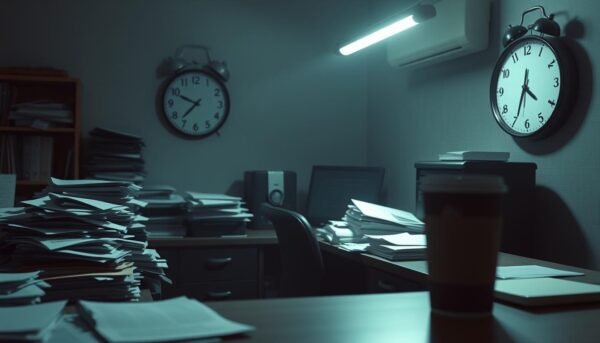Do you always feel tired, emotionally drained, and can’t keep up with work? These could be signs of burnout. It’s a state of exhaustion that affects your health and mind. How can you spot these signs early? Let’s look at the key signs and how to stop burnout before it’s too late.

Burnout is feeling emotionally, physically, and mentally exhausted from too much stress. It happens when you’re overwhelmed and can’t meet demands. You might feel tired, get sick often, have headaches or muscle pain, and sleep or eat differently.
You might also feel like a failure, helpless, and trapped. Does this sound like you? If yes, it’s time to tackle the burn out symptoms, exhaustion signs, and stress indications at work.
Understanding Workplace Burnout and Its Impact
Burnout is a big problem in today’s fast work world. It’s more than just feeling stressed or overwhelmed. Burnout affects our mental health, physical health, and how well we do at work. As a journalist, I’ve learned a lot about burnout.
Defining Modern Burnout
Burnout is feeling very tired and emotionally drained from work stress. It’s not a medical term, but the World Health Organization recognized it in 2019. It makes you feel cynical, detached, and less accomplished, hurting your well-being.
The Difference Between Stress and Burnout
Stress and burnout are different. Stress is too much pressure and not enough time. Burnout is feeling drained and lacking motivation and purpose. Stress can be managed, but burnout needs a deeper fix.
How Burnout Affects Professional Performance
Burnout really hurts how well you do at work. You get tired and less productive. You might start to dislike your job and feel less like working with others. Burnout also makes you more likely to get sick, making work even harder.
| Workplace Burnout Statistics | Percentage |
|---|---|
| Workers who experienced job-related stress in the past month | 79% |
| Workers actively seeking new jobs or thinking about a fresh start | 44% |
| Hybrid employees reporting feeling lonelier at work than before the pandemic | 55% |
| All-remote employees reporting feeling lonelier at work than before the pandemic | 50% |

It’s key to understand burnout to tackle this big problem. By spotting signs, fixing the root causes, and taking steps to prevent it, we can help people and companies do better in today’s work world.
Physical Manifestations of Professional Exhaustion
Work pressure can really take a toll on our bodies. Signs like chronic fatigue and insomnia show we need to take a break. Forgetfulness is another sign that we’re stressed out at work.
Stress from work can lead to serious health issues. High cortisol levels can cause stomach problems and headaches. It can even hurt our hearts and weaken our immune system.
Feeling tired all the time, getting sick often, and sleeping poorly are big warnings. If ignored, these can lead to serious health issues like obesity and diabetes. It’s important to notice these signs early to prevent bigger problems.

Burnout is common in many jobs, especially in healthcare and teaching. Working from home can make it worse. To avoid health problems, we need to manage stress and take care of ourselves.
Burn Out Symptoms: Mental and Emotional Red Flags
Burnout is more than just feeling tired. It affects our mind and heart too. Spotting the early signs of burnout is key to keeping our health and job success.
Changes in Mood and Attitude
One big sign of burnout is a change in how we feel. People might get angrier, more frustrated, and feel negative. They might also feel disconnected from their job.
Cognitive Function Changes
Burnout can mess with our thinking skills. It makes it hard to focus, solve problems, and be creative. They might have trouble remembering things, making decisions, and staying productive.
Social Withdrawal Patterns
Another sign is pulling away from others. People might stop going to team meetings and talk less to their coworkers. This can make them feel lonely and stuck in burnout.
It’s important to tackle these signs early. Taking care of ourselves, getting help, and balancing work and life can help. This way, we can find our motivation and happiness again.

The Five Stages of Burnout Development
Burnout is a serious condition that affects our personal and professional lives. Knowing the five stages of burnout helps us spot warning signs early. This way, we can take steps to prevent it.
- Honeymoon Phase: This first stage is filled with enthusiasm, energy, and commitment to work. People in this phase are motivated and eager to succeed.
- Onset of Stress: As work demands grow, stress starts to show. You might feel irritable, sleep less, and get anxious. This is a sign you need better balance between work and life.
- Chronic Stress: When stress is too much, you’ll see physical and behavioral changes. You might get sick, pull back from social life, or drink more. This means burnout is coming.
- Burnout: In this stage, you feel drained, both emotionally and physically. You might feel pessimistic, doubt yourself, and get too caught up in work problems.
- Habitual Burnout: If burnout isn’t treated, it can become a big part of your life. It can lead to depression, mental health issues, and a lack of motivation.
It’s important to recognize these stages early to avoid severe burnout. By watching for warning signs and taking steps to manage stress, we can keep our well-being. This helps us have a healthy and productive career.

Workplace Factors Contributing to Employee Burnout
Workplace fatigue and employee overload are big problems today. Fast-paced work environments are demanding. It’s key to know what workplace factors lead to burnout in professionals.
Organizational Culture Impact
The culture in a workplace greatly affects burnout rates. Unreasonable time pressures and unfair treatment can cause burnout. If an employee’s values don’t match the company’s, they may feel stressed and unhappy.
Work-Life Balance Disruption
Work and personal life balance is often disrupted. On-site perks might make employees stay longer, hurting their balance. Overwork leads to exhaustion, affecting health and productivity.
Professional Relationship Strain
Good relationships at work are important. Lack of support and unfair treatment can make employees feel isolated. Creating a positive work environment helps prevent burnout.

Personal Risk Factors and Vulnerability Assessment
Knowing your personal risk factors is key to spotting career stress and burnout signs. Some people are more likely to face mental health issues because of their personality and lifestyle.
Perfectionists and those with a Type A personality are more at risk. They are competitive, act on impulse, and set too many goals. On the other hand, people who think their life is controlled by others might also face more challenges.
Women, especially those in helping jobs and living with a partner, have a harder time. They often have to care for their families and work hard too. Research shows women tend to feel more exhausted and less fulfilled in their jobs than men.
| Risk Factor | Impact on Burnout |
|---|---|
| Perfectionism | Increased vulnerability |
| Pessimism | Heightened risk |
| Poor self-care habits | Amplifies burnout symptoms |
| External locus of control | More prone to burnout |
| Type A personality | Higher susceptibility |
Looking at these risk factors can help you see if you’re at risk for burnout. By knowing your weak spots, you can start to build your strength. This way, you can keep your work and personal life in balance.

Early Detection and Prevention Strategies
It’s key to spot burnout signs early to keep your health and job performance up. Check your energy, mood, and how you feel about work often. Tools like tracking stress and a work-life balance journal can give you clues about your health.
Self-Assessment Tools
Use tools like the Maslach Burnout Inventory to see how much burnout you have. These tests show if you’re feeling drained, distant, or not as good at your job. They help you start fixing problems before they get worse.
Daily Monitoring Techniques
Watch your energy, mood, and work feelings every day. A daily journal can help you see patterns and catch burnout early. Knowing what causes exhaustion signs or stress indications lets you take steps to prevent occupational burnout warnings.
Professional Support Options
If you see exhaustion signs, stress indications, or occupational burnout warnings, get help. Look into employee programs, counseling, or talk to your boss about your work load. Tackling burnout early can make you feel better, work better, and stay healthy.
This post may contain affiliate links which means I may receive a commission for purchases made through links. I will only recommend products that I have personally used! Learn more on my Private Policy page.